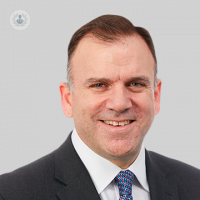How to treat shoulder impingement
Escrito por:Subacromial impingement is one of the most common causes of shoulder pain. It occurs when the tendons inside the shoulder catch or rub on a nearby bone or tissue when lifting the arm. It can cause an ache when trying to sleep, pain when moving the arm and general weakness.
Leading orthopaedic surgeon Mr Mark Falworth explains how to improve subacromial impingement and, in some cases where it is more difficult to treat, just what surgical options are available…

What is shoulder impingement?
The rotator cuff is a group of four muscles which envelope the ‘ball’ of the shoulder joint (humeral head). The muscles help lift the arm, but they are also instrumental in keeping the humeral head down and away from the acromion. Between the acromion and the rotator cuff is the subacromial space in which there is a fluid-filled sac called the bursa. The bursa helps to provide a smooth, low friction environment for the shoulder to move. Impingement can occur when there is a reduction in the space between the rotator cuff tendons and the overlying bone, the acromion.
However, it is important to realise that impingement is not a diagnosis, but instead, a description of the rubbing that can occur between the tendons and the overlying acromion. The pain associated with impingement can be most apparent during shoulder movement, and in particular when the arm is elevated to shoulder height or when the arm is rotated. This may also result in clicking and if bursitis and inflammation continue, then progressive thickening and scarring of the bursa can occur which will further restrict movement and potentially also cause night pain.
What causes subacromial impingement?
There are many causes of shoulder impingement but if the rotator cuff is weak or injured, or if there is a build up of bone on the under the surface of the acromion (sometimes referred to as a bone spur), inflammation can occur within the subacromial bursa. This is known as subacromial bursitis and can result in swelling with associated pain and restricted movement. Conditions such as calcific tendonitis, the presence of a torn tendon or even subtle shoulder instability can also result in impingement pain.
The diagnosis of subacromial impingement is made clinically however, X-rays can be used to confirm the presence of an acromial bone spur but often ultrasound scans are the most effective investigation. In the presence of a suspected rotator cuff tear, an MRI scan might be indicated.
How is shoulder impingement treated?
There are a number of treatments available for subacromial impingement, however, often more than one treatment modality is necessary. Non-surgical treatment may include:
- Conservative treatment - combining rest, activity modification and the use of anti-inflammatory medications.
- Stretching - eventually strengthening exercises can be used to keep the humeral head low and away from the acromion, thereby minimising the risk of impingement-like symptoms. It may be recommended to work with a physiotherapist.
- Injections - local anaesthetic and Cortisol into the subacromial space can be used for both diagnostic and therapeutic reasons. The anti-inflammatory component of the injection can reduce swelling and pain and can also be used in conjunction with physiotherapy to aid recovery.
In more severe cases of shoulder pain and impingement, surgery may be necessary. An arthroscopic subacromial decompression can be used in those cases resistant to non-operative treatment. This is a key-hole operation used to remove any inflamed tissue and some of the bone of the acromion (or a spur) to create more space so that the rotator cuff tendons are not aggravated during shoulder movement.
Where appropriate, other procedures such as rotator cuff repairs or ACJ excisions can also be performed at the same time. A sling is usually worn for 10-14 days and physiotherapy is necessary following the procedure.


